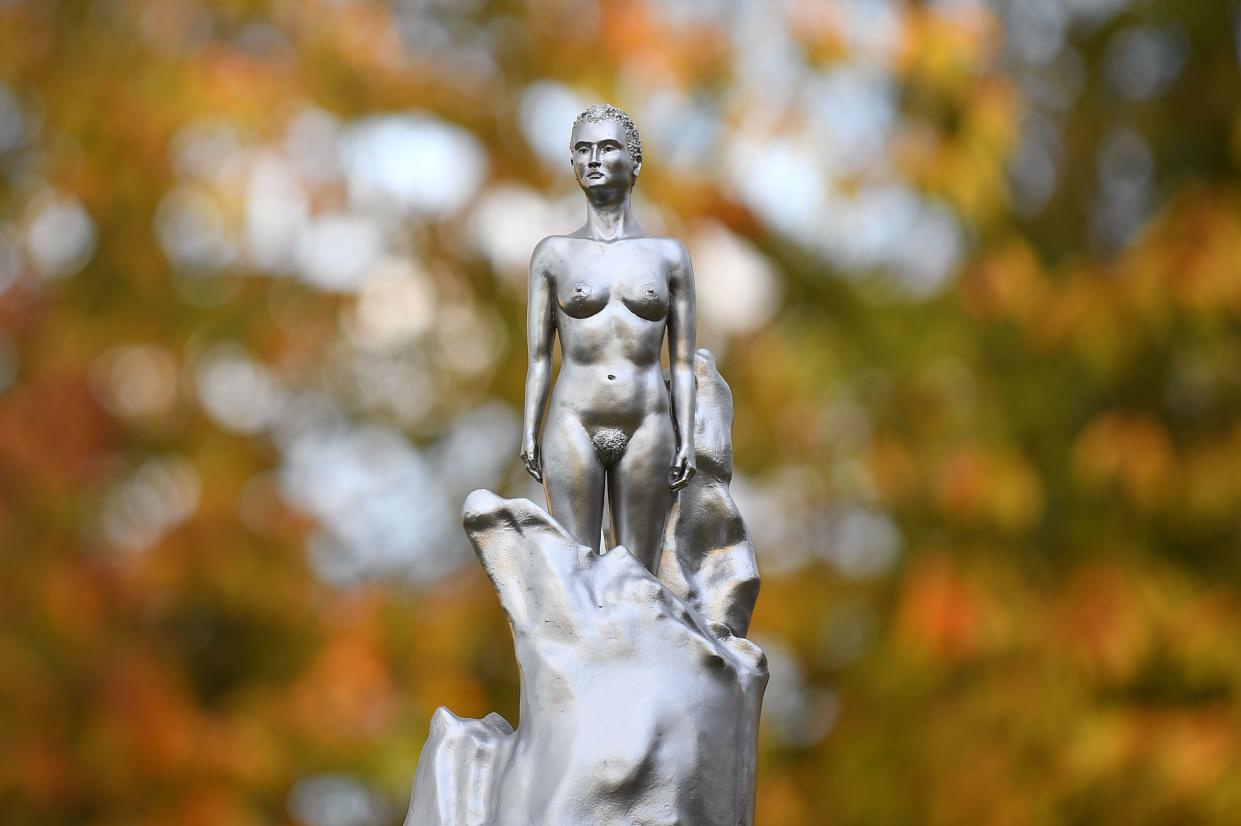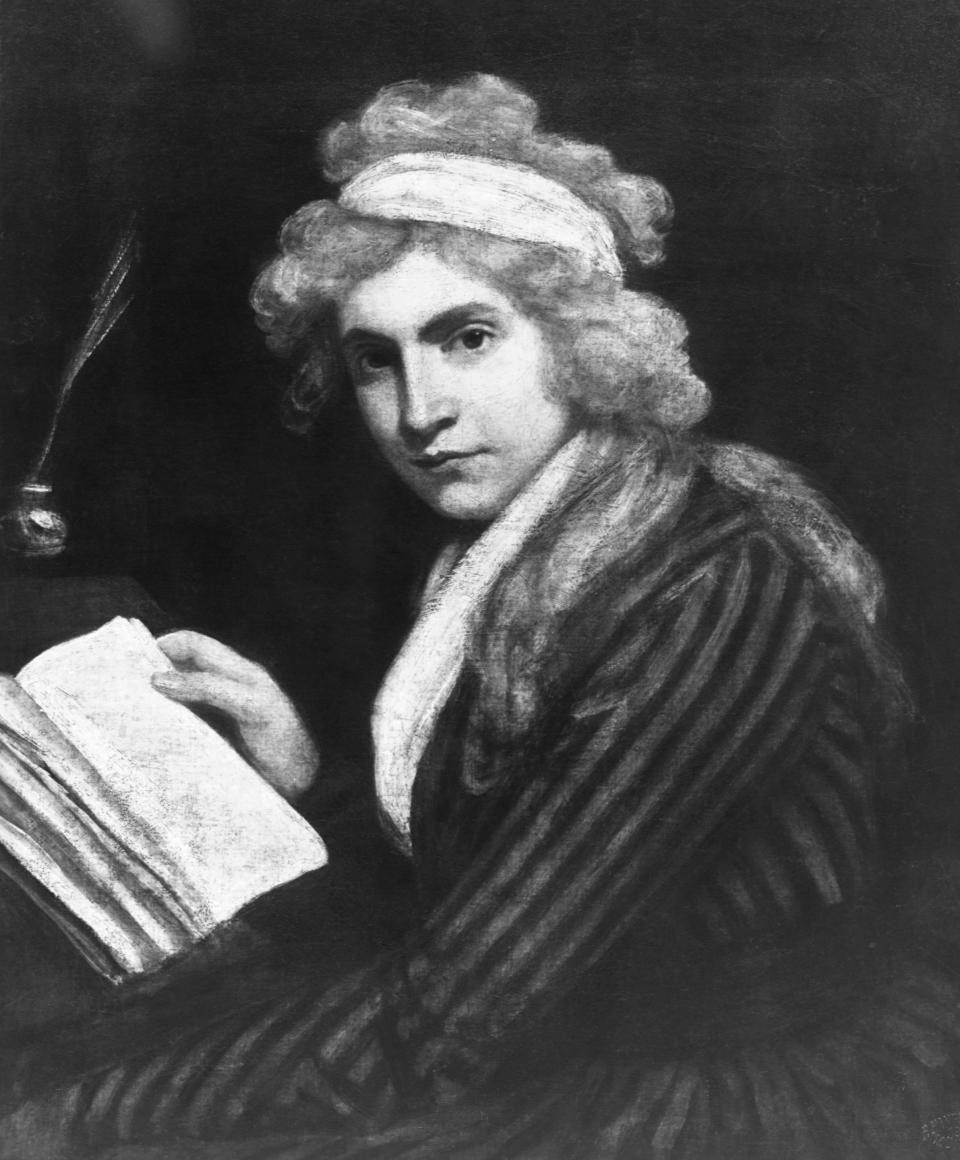Naked sculpture honoring feminist icon Mary Wollstonecraft sparks backlash: 'Insulting'

- Oops!Something went wrong.Please try again later.
- Oops!Something went wrong.Please try again later.
Mary Wollstonecraft — the British feminist writer and philosopher who advocated for the social and educational equality of women, in the 18th century, no less — has been honored with a public statue, unveiled in London on Tuesday. But a growing chorus of critics says it’s no honor at all. Why? The cast bronze sculpture depicts the icon in the nude, and in her youth, despite the bulk of her accomplishments being achieved late in her life.
Criticisms of the sculpture, created by renowned artist Maggi Hambling after a long fundraising effort, were harsh and immediate, with people calling it “catastrophically wrong” and “insulting.”
Writer Tracy King told the Guardian: “Any passing teenage boy is not going to think, oh, that’s an icon of feminist education. They are going to think – tits!”
Local protesters, in fact, took matters into their own hands Wednesday by covering up the silvered bronze figure with a black T-shirt that reads, “Woman noun adult human female.”

“The statue shows the great Wollstonecraft as tiny and represented like a porn star, it’s awful,” Janice Williams, one of the women who added the T-shirt, told the Evening Standard. “In the statue she is young — but she achieved great things when older.”
Writing in an opinion piece for the Guardian, Rhiannon Lucy Cosslett noted, “It is hard to imagine a male writer or thinker being ‘honored’ by a sculpture of a tiny naked man, schlong out for all to see, ripped like a Ken doll, emerging from a mass of what we are told is ‘organic matter.’ It is a huge missed opportunity.

Outrage kept on coming on social media, including a sarcastic tweet from author Caitlin Moran and the lively thread of clothed-women sculptures it inspired:
This is the new statue of Mary Wollstonecraft. It's not making me angry in any way because I just KNOW the streets will soon be full of statues depicting John Locke's shiny testicles, Nelson Mandela's proud penis, and Descartes adorable arse. https://t.co/LMbxDtMHI1
— Caitlin Moran (@caitlinmoran) November 10, 2020
I prefer the statue of Danuta Dielsson clouting a neo-Nazi in Växjö, Sweden.
Photo Hans Runeson pic.twitter.com/dJdKEfjick— Brian Cope (@BrianCo48405777) November 10, 2020
Vancouver's giant nurses are not impressed pic.twitter.com/WGjCd2Brsi
— Jen Eggleston (@Jen_Eggleston) November 10, 2020
Wollstonecraft is best known for her 1792 book A Vindication of the Rights of Women, which argues that women are not naturally inferior to men; her daughter is Frankenstein author Mary Shelley. The sculpture controversy prompted feminist author Sophie Walker to kick off a passionate discourse on Twitter, along with journalist Julia Hartley-Brewer:
I am glad that we are all talking about #MaryWollstonecraft today. I think it's really important to celebrate and mark with public statues the contribution of women. I know how hard and for how long the team worked to make this happen. I also really wish it wasn't a naked statue.
— Sophie Walker (@SophieRunning) November 10, 2020
As a general rule, when you put up a statue to celebrate the contribution of a woman who fought for women to be recognised as equals to men and thus deserving of voting rights, it's probably not *ideal* for that statue to be of a ***NAKED*** woman. FFS.
🤯😡 #MaryWollstonecraft pic.twitter.com/7vORsBhH6k— Julia Hartley-Brewer (@JuliaHB1) November 10, 2020
After all, I'm sure we have all been inspired by the many naked statues of influential and inspiring men like Martin Luther King and Winston Churchill, right..? 🙄 pic.twitter.com/z1T2Ib3jpN
— Julia Hartley-Brewer (@JuliaHB1) November 10, 2020
Piers Morgan couldn’t help himself from weighing in:
Feminists screaming at feminists for objectifying a feminist icon by representing her life with a titillating nude statue is... hilarious. Well done ladies! #MaryWollstonecraft pic.twitter.com/7q6S8w8Y8Z
— Piers Morgan (@piersmorgan) November 11, 2020
Others just had some fun with their critiques:
I’m loving the new statues of Boris Johnson, Jermeny Corbyn, Neslon Mandela and Steven Hawking#MaryWollstonecraft pic.twitter.com/POOwzTMf5T
— coccinellanovem (@coccinellanovem) November 10, 2020
#MaryWollstonecraft seeing her statue for the first time pic.twitter.com/nsSVUbNG4z
— Susan Harrison (@SueHarrison123) November 11, 2020
Love the new #MaryWollstonecraft statue! pic.twitter.com/kAHMLiLoqs
— Harpy. (@harpy_mag) November 10, 2020
The statue took 10 years and about $190,000 of funding to create, and its artist, in the wake of criticism, has forcefully defended her work.
“You can’t be naked enough can you?” Hambling told the Evening Standard, laughing off criticisms.
“The point is that she has to be naked because clothes define people. We all know that clothes are limiting and she is everywoman. As far as I know, she’s more or less the shape we’d all like to be.”
Hambling said the critics had confused Wollstonecraft with the figure in the work, adding, “She’s everywoman and clothes would have restricted her. Statues in historic costume look like they belong to history because of their clothes. It’s crucial that she is ‘now.’ The whole sculpture,” she said, “is called ‘for Mary Wollstonecraft’ and that’s crucially important. It’s not an idea ‘of’ Mary Wollstonecraft naked… the sculpture is for now.”
Read more from Yahoo Life:
Want lifestyle and wellness news delivered to your inbox? Sign up here for Yahoo Life’s newsletter.


